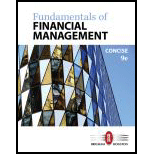
Concept explainers
a.
To compute:
Present Value of Cash Flow:
It is also called as discounted value; it defines that amount of money that is invested at a given rate of interest will increases to the amount of future cash flow at that particular time in the future.
b.
To compute: Present value of $500 at 12% nominal rate, quarterly compounding, and discounted back 5years.
Present Value of Cash Flow:
It is also called as discounted value; it defines that amount of money thatis invested at a given rate of interest will increases to the amount of future cash flow at that particular time in the future.
c.
To compute: Present value of $500 at 12% nominal rate , monthly compounding, discounted back 1year.
Present Value of Cash Flow:
It is also called as discounted value; it defines that amount of money thatis invested at a given rate of interest will increases to the amount of future cash flow at that particular time in the future.
d.
To explain: Reason of difference in present value of part a andb.
Present Value of Cash Flow:
It is also called as discounted value; it defines that amount of money that is invested at a given rate of interest will increases to the amount of future cash flow at that particular time in the future.
Want to see the full answer?
Check out a sample textbook solution
Chapter 5 Solutions
Fundamentals of Financial Management, Concise Edition (MindTap Course List)
- What does "liquidity" refer to in finance? A) The profitability of a companyB) The ease of converting assets to cashC) The value of fixed assetsD) The number of outstanding sharesarrow_forwardI need answer in this problem quickly. The Weighted Average Cost of Capital (WACC) includes: A) Cost of equity and cost of debtB) Only the cost of equityC) Only the cost of debtD) Total revenue of the companyarrow_forwardHelp me in this question. The Weighted Average Cost of Capital (WACC) includes: A) Cost of equity and cost of debtB) Only the cost of equityC) Only the cost of debtD) Total revenue of the companyarrow_forward
- Need answer! The Weighted Average Cost of Capital (WACC) includes: A) Cost of equity and cost of debtB) Only the cost of equityC) Only the cost of debt D) Total revenue of the companyarrow_forwardThe Weighted Average Cost of Capital (WACC) includes: A) Cost of equity and cost of debtB) Only the cost of equityC) Only the cost of debtD) Total revenue of the companyarrow_forwardWhich of these is NOT part of the 4Ps in marketing but relevant to finance? A) PriceB) PromotionC) PlaceD) Profitabilityarrow_forward
- I need correct answer. If a bond’s price increases, its yield will: A) IncreaseB) DecreaseC) Remain the sameD) Be unpredictablearrow_forwardWhat is the primary goal of financial management? A) Maximizing revenuesB) Minimizing costsC) Maximizing shareholder wealthD) Increasing market share need help!arrow_forwardThe time value of money concept assumes that: A) A dollar today is worth more than a dollar in the future B) A dollar in the future is worth more than a dollar today C) Money loses value only when interest rates rise D) Money value remains constant over time need help!!arrow_forward
- What does ROI stand for in finance? A) Return on InvestmentB) Revenue on InvestmentC) Rate of InterestD) Risk of Investment need answer!arrow_forwardThe time value of money concept assumes that: A) A dollar today is worth more than a dollar in the futureB) A dollar in the future is worth more than a dollar todayC) Money loses value only when interest rates riseD) Money value remains constant over timearrow_forwardWhat is the primary goal of financial management? A) Maximizing revenuesB) Minimizing costsC) Maximizing shareholder wealthD) Increasing market sharearrow_forward

